![]()
![]()
![]()
Use LEFT and RIGHT arrow keys to navigate between flashcards;
Use UP and DOWN arrow keys to flip the card;
H to show hint;
A reads text to speech;
41 Cards in this Set
- Front
- Back
- 3rd side (hint)
|
What is diffusion? [1.1] |
Movement of gaseous particles from a high concentration to a low concentration through a semi-permeable membrane. |
Concentration gradients |
|
|
What is osmosis? [1.1] |
Movement of water from a high concentration to a low concentration through a semi-permeable membrane. |
Similar to diffusion. |
|
|
What is the difference between osmosis and diffusion? [1.1] |
Osmosis is essentially diffusion but with water rather than gases. |
|
|
|
How can osmosis cause problems in animal cells? [1.1] |
● If the solution outside of a cell contains more water than what is inside the cell, it can travel into it and burst the cell. ● If the solution is very low in water, the water inside the cell is drawn out through osmosis and the cell shrinks and can no longer survive. |
|
|
|
What is the concentration gradient? [1.2] |
High concentration 》Low concentration |
|
|
|
What is active transport? [1.2] |
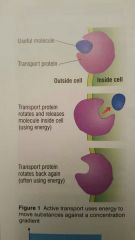
Movement of substances (typically ions) against the concentration gradient using protein carriers. |
|
|
|
(i) What does active transport require? (ii) Where does it get this from? [1.2] |
(i) It takes energy for the active transport system to carry a molecule across the membrane. (ii) The energy is obtained from cellular respiration. |
|
|
|
What would cells that have to carry out lots of active transport require? [1.2] |
Mitochondria. |
|
|
|
How do you lose water and mineral ions when you exercise? [1.3] |
You sweat to keep your body temperature stable, and water and ions are lost through this. |
|
|
|
What will happen if the water and ions lost through exercise are not replaced? [1.3] |
The mineral/ion concentration will rise and the cells will not work as efficiently as usual. |
|
|
|
What is a sports drink? [1.3] |
A drink made to replace lost substances. Mainly containing water, often glucose. It contains more mineral ions and has artifical colouring and flavouring to make it more pleasant. |
|
|
|
What is meant by the term "isotonic"? [1.3] |
Equal osmotic pressure. Same amount of water and ions as in the blood. |
|
|
|
Why does gaseous and solute exchange get more difficult as organisms become bigger and more complex? [1.4] |
Gases and food molecules can no longer reach every cell inside the organism through simple diffusion. |
|
|
|
What makes an effective surface area? [1.4] |
● Having a large surface area ● Being thin, which provides a short pathway for diffusion ● Having a rich blood supply (in animals). This moves the substances away and maintains a concentration gradient. ● Being ventilated to make gaseous exchange easier and keeping a steep gradient. |
|
|
|
How is the tongue of a common musk turtle adapted for gaseous exchange? [1.4] |
It is covered in tiny buds that increase surface area and the tongue has good blood supply. |
|
|
|
What are the alveoli? [1.4] |
Small air sacks within the lungs. |
|
|
|
How do the alveoli adapt the lungs for gaseous exchange? [1.4] |

They allow the lungs to have a very large surface area which is important for oxygen and carbon dioxide diffusion. They also have a rich blood supply and are well ventilated. |
|
|
|
Cross section of alveoli [1.4] |
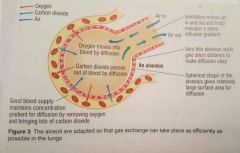
|
|
|
|
What is meant by "ventilating the lungs"? [1.5] |
Maintaining a steep concentration gradient of both oxygen in and carbon dioxide out; or breathing. |
|
|
|
What is the thorax? [1.5] |
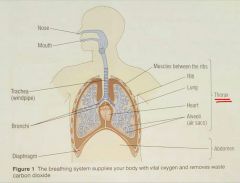
Where the lungs are in the ribcage, separated from the digestive organs by the diaphragm; or the chest. |
|
|
|
Moving air in and out of the lungs [1.5] |
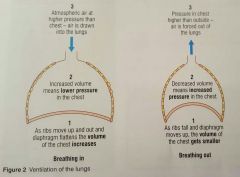
|
|
|
|
What is the sequence for breathing in? [1.5] |
1. Muscles contract
2. Volume of thorax increases
3. Pressure in thorax decreases
4. Air enters lungs |
|
|
|
What muscles bring about the ventilation of the lungs? [1.5] |
Intercostal muscles which contract to pull the ribs upwards and outwards. At the same time the diaphragm muscles contract which, combined with the intercostal muscles, increases the volume of the thorax. The pressure inside the thorax drops and as a result of this, air rushes into the lungs. When the muscles relax, the ribs drop down again and the diaphragm curves back up to reduce the volume of the thorax, therefore increasing the pressure and releasing air back out of the lungs. |
|
|
|
Why might someone need breathing aids? [1.6] |
● The bronchi may be very narrow so less air gets through them
● The structure of the alveoli can break down. This results in few big air sacs that have a smaller surface area for gas exchange.
● Being paralysed or injured in accidents |
|
|
|
What two main ways do breathing apparatuses work? [1.6] |
Negative pressure and positive pressure. |
|
|
|
What is an "iron lung"? [1.6] |
It is an external negative pressure ventilator. They lay in a metal cylinder with their head protruding and a tight seal around their neck. Air is pumped out of the chamber, lowering pressure to create a vacuum. As a result of this, the patient's chest moves up and increases the volume of the thorax to aid in respiration. It switches on and off at regular intervals to stimulate breathing. |
|
|
|
How do positive pressure ventilators work? [1.6] |
They force a carefully measured "breath" of air into the lungs under a positive pressure. Once the lungs have been inflated the pressure stops and they deflate to force the air back out of the lungs. It can be given using a face mask or a tube going into the trachea. Small pressure bags are used by doctors and full scale machines are used in surgery. |
|
|
|
Why must the products of digestion get into the bloodstream? [1.7] |
They are turned into fatty acids, amino acids, glycerol and simple sugars like glucose which are needed for respiration and growth and repair. |
|
|
|
(i) What are villi? (ii) What is their purpose? [1.7] |
(i) Villi (singular. Villus) are thousands of tiny, finger-like projections lining the small intestine. (ii) They greatly increase the surface area for diffusion of dissolved food particles into the bloodstream. |
|
|
|
Why is it important that villi have a rich blood supply? [1.7] |
Because the food particles need to be transferred into the bloodstream. Capillaries wrapped around each singular villus allow this to happen. |
|
|
|
Cross section of a villus [1.7] |

Active transport also occurs in the small intestine. |
|
|
|
How are leaves adapted for efficient diffusion of carbon dioxide? [1.8] |
The flattened shape of the leaves, the thinness, and the many air spaces keeping it well ventilated. |
|
|
|
Cross section of a leaf [1.8] |
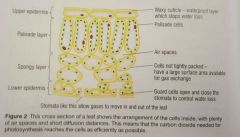
|
|
|
|
Why don't leaves need carbon dioxide constantly? [1.8] |
When it is dark, they do not need carbon dioxide because they are not photosynthesising. |
|
|
|
How is carbon dioxide intake controlled? [1.8] |
A waxy cuticle covering is water and gasproof. There are also stomata which are small openings controlled by guard cells. They open and close. |
|
|
|
How are plant roots adapted to take water and mineral ions from the soil? [1.8] |
The roots are thin divided tubes with large surface area. The cells have small projections.
It is moved up through the xylem to the other parts of the plant. The root cells are also adapted to take in mineral ions using active transport. |
|
|
|
What is transpiration? [1.9] |
The loss of water vapour from the surface of plant leaves is known as transpiration. |
|
|
|
What is the transpiration stream? [1.9] |
As water evaporates from the surface of the leaves through open stomata, more water is pulled up though the xylem from the roots to replace the loss. |
|
|
|
What increases the rate of transpiration? [1.9] |
● Warm, sunny conditions ● Windy conditions ● Everything that effects the rate of photosynthesis |
|
|
|
What is wilting? [1.9] |
Wilting is a protection mechanism against further water loss and occurs when the plant begins to lose water faster than it can replace it.
The leaves all collapse and hang down so the surface area avaliable for water loss by evaporation is greatly reduced. The stomata close which stops photosynthesis and risks overheating. The plant remains wilted until the temperature drops, the sun goes in or it rains. |
|
|
|
What is a potometer? [1.9] |
TAKE PICTURE It can be used to show how the uptake of water by the plant changes with different conditions. |
|

